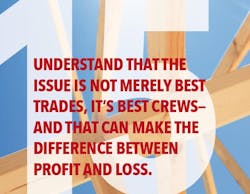15 Ways to Solve Your Trade Shortage
In my article in the February 2017 issue of Professional Builder, we reviewed the results of the TradeComm survey conducted by my company, TrueNorth, with special emphasis on comparing results prior to the housing crash to results today. TradeComm solicits direct, anonymous feedback from suppliers and trades about builder operations and processes such as plans, product specifications, waste management, and communication of all kinds. The disturbing trend: Builder scores have dropped across the board compared with pre-crash levels, at a time when trade shortages are a limiting factor virtually everywhere across the country.
The irony is mind-numbing. Just when the industry needs a dependable supply of high-quality trades more than ever, we’re doing an inferior job of managing both our trades and our own operations. That means higher cost, degraded quality, inflated schedules, and depressed margins. Yet, as discussed in the February column, these results present a clear opportunity for competitive advantage. Knowing that most of your competitors are part of the gang looked upon less favorably by suppliers and trades, what happens if you’re the builder that stands out? Obvious, isn’t it? If your team does the work to identify and focus on the two or three biggest issues this year that hold you back in the eyes of suppliers and trades, you’ll see nearly all elements of your operation improve, including profit.
Bigger Not Doing Better
I held back one key result from the February column, wanting to save it for the annual Housing Giants issue. If you’re a large builder that can’t stomach tough feedback or you love to play “shoot the messenger,” just stop here because you’ll not like what comes next.
Put simply, on average, the biggest builders score lower on the TradeComm survey than their smaller counterparts. To further break it down, national builders score lowest of all. This is truly remarkable. The largest of the Giants not only have more resources but also claim to have more expertise and ardently promote this notion. That’s half right. Yes, they have more resources, but no, they don’t possess more expertise—or if they do, it goes unheeded. This isn’t opinion; I’m simply stating what the TradeComm data shows. Don’t care much for that message? Time to load the guns and shoot the messenger? Let’s first deal with the messenger because if you don’t accept the source, you’ll never hear the message.
I spent most of a decade as a corporate VP for a large national builder—a true Housing Giant—and worked in more than 30 divisions across the entire country. I had a nice budget, plenty of help, and almost limitless sanction and willing participants to try things, watch the outcomes, learn, then try to spread the knowledge. Much of our effort was spent on the relationships, efficiency, and development of suppliers and trades. The creativity of many of the field operations was incredible, since there was little central control as long as you made your numbers, and divisions could pretty much try whatever they wanted. Even those divisions that showed no interest in taking part in the experiments and trials were key to the process, serving as control groups. The opportunity to watch 30 different building operations from the inside as we went through tremendous growth and cultural change was an experience for which there’s no substitute. Toward the end of my tenure, we shifted to a more centralized control model with too many corporate and regional VPs engaged in forced replication of the builder’s presumed “best practices,” and with most experimentation discouraged, the rate of learning was suppressed. At that point, I concluded it was time to move on.
Since launching TrueNorth 20 years ago this summer, my colleagues and I have worked with well over 200 builders of all sizes and types in five countries. I annually present at 15 to 20 conferences, where, following each event, I hear from myriad builder personnel. With nearly 20 years writing a monthly column, I get continual calls and email from your people wanting to ask questions, float ideas, find resources, or to just talk. And then there are the results from the TradeComm survey itself. The message emerging from all of this work is clear and inarguable; there’s just too much supporting data. But if you still think we don’t have a good handle on the supplier/trade issue, channel the late Chuck Barris, smack that gong, and move on to the next article.
Our Current Business Model Works Against Us
If the topic wasn’t so serious, we could have a chuckle over the barrage of trade-shortage articles showing up in the business press in the past year, as if it was a recent phenomenon. Nothing could be further from the truth. During the first Obama presidential campaign more than nine years ago, I published a column on the issue and described the coming shortage and its ties to immigration policy as the “elephant in the room” no one would attack head-on. What baffles me though, is how our industry—particularly the biggest builders, with all of their resources—continue to do so little to solve this problem, tied up in a business model that works their current trades to the bone, compromises quality, kills the schedule, puts ridiculous pressure on their own staff, and constitutes the single largest drag on profit you’ll find today. Yet we have an abundance of evidence on what works and what doesn’t in the quest for building and maintaining a sustainable labor pool.
Essentials for Solving the Labor Shortage
What follows are the 15 ways in which strong locals consistently do better than nationals or multi-divisional regionals.
1. Communicate, communicate, communicate. TradeComm survey feedback clearly shows that suppliers and trades want to know: What are your plans? How much business is in the pipeline? How do customers rate you? What does the economy look like for the next year? And so on. They can’t respond like true partners in the business if you don’t treat them as such.
2. Ditch bid price as your sole criterion and resolve to buy only on total cost, which is the one thing that really matters. Total cost includes design, materials selection, installation methods, delivery, quality, labor cost, interaction with other labor and materials, administrative costs, warranty, safety, and sustainability. Ignoring the totality of the costs is a fool’s game. Sure, it’s more work to calculate up front, but it’s less work in the long run and will be far more profitable.
3. Know that to get the best trades, you must earn them. Get really specific. Ask trades exactly what their No. 1 Builder of Choice does that’s different from what you do. Beg them for honesty. Now share that feedback with all your people and take time to understand and internalize the information. Then figure out how to one-up your competitors.
4. Understand the issue is not merely best trades, it’s best crews, and that can make the difference between profit and loss. Best crews do high-quality work, minimize waste, arrive on time, complete on time, keep you informed, leave a clean jobsite, and work and play well with others. Crew quality can make or break your schedule. Bottom-of-the barrel crews do none of that, and average crews achieve only a couple of those factors on any given day. You need the best, but—as I say in No. 3—you have to earn them. So since you’ve already scheduled the meeting, ask not just what it takes to be at the top of their list, but what it takes to earn their best crews.
5. Kill the paperwork load. Do this exercise: Assemble every piece of paper, email, online document, or form that a trade must use during the process of building your homes. Now, cut that in half this year and repeat as needed. We are killing trades with administrative inefficiency.
6. Simplify wherever possible. The only sensible way to operate is this: You can have as many options as you like if—and only if—you have systems, processes, and trained people to proactively manage them. Be honest. Can you meet that standard? Few builders do. Any shortfall here throws a super-size wrench in the process, and both you and your trades will pay the price many times over.
7. Bid packages 100 percent complete, with final plans and specifications fully detailed and accurate. There is only one way to be sure you nail this one. Ask each supplier and trade exactly what they need to do their most accurate and tight costing of your project. Now go get it for them. No excuses.
8. Start packages 100 percent complete, detailed, and accurate with job-specific plans and working drawings. See No. 7—and if you think this costs too much, you’re either lousy at math or you’re counting the wrong things.
9. Negotiate firm dates with sales and the design center for all options and selections and hold sales accountable to manage customers to those dates. We hear continual laments about how impossibly difficult this is to do and make sales while keeping customers happy. Yet we know too many builders that do it every day and their profit margins are higher than yours. Either figure it out or accept marginal results.
10. Manage VPOs down to the minimum. Every VPO is a loss—for builder, supplier, and trade alike. Accept no excuses, but that requires doing the hard work contained in nearly every point in the first nine points above. Failures in those are what cause VPOs. Cut them in half this year, then again next year, and again the next. Now you’re getting close.
11. Reduce charge-backs to an absolute minimum, with a goal of zero. Like VPOs, each charge-back is a loss for all. The blame game resolves nothing and perpetuates the problem. The best builders have the lowest levels of charge-backs to and among suppliers and trades. We know one 2,500-unit builder that has exactly none. If you’re truly doing your part to prevent charge-backs, yet workplace damage and rework continues at a high level, you’re working with the wrong trades.
12. Have the best-trained field construction managers in town. This must be intentional, not casual. Just having worker training worker is insufficient and inbreeds poor practices and processes. Injecting new people hired from competitors will worsen the problem. Establish your operations practices and processes, document them, streamline as much as possible, and train everyone on them. Be vigilant. Don’t relent.
13. Maintain an intelligent, proactive schedule that reflects the true capability of your systems, processes, and people working within the current capacity of your suppliers and trades. Level your production flow weekly, monthly, quarterly, annually, and keep it that way. There’s absolutely zero credible evidence that closings must be higher in the last week of the month, the last month of the quarter, or the last quarter of the fiscal year. An analysis of multiple builders with fiscal years ending anywhere from April through December shows that all have the same problem with jamming production in each period and especially at year end. Failure to solve this sends a clear message to suppliers and trades that you as a builder care nothing about their ability to manage their businesses, only your short-term profit.
14. Offer nonmonetary rewards. Every research study ever done on compensation shows employees want far more than just a competitive salary. TradeComm data backs that up. Why should your suppliers and trades be any different? They want to work for a good company that cares about them and listens to their input on product and process. Paying fairly and on time is just table stakes to be in the game. If you fail there, everything else is a waste of time. There’s more to it than money, though, and it’s your challenge to figure that out.
15. Accept your responsibility to become involved and show leadership on the local level in the development of the trade base and demand the same of your colleagues, competitors, school officials, and politicians. I’ve written ad nauseam about both the requirements to do this and the many ways it has been done. Yet, in all of those articles, you find it’s the smaller builders that lead the way on this, not the biggest ones. How can this be? Will you really take the tack that it’s OK to just sit back and let others solve the problem, then assume you can steal from their pool of results to meet your trade labor needs? Is that any way to run a multimillion dollar business?
It All Comes Down to Culture
That’s a lot to contemplate and even more to do, but you have little choice. If you still doubt me, here’s another fun fact: The strong local builders by and large are substantially more profitable than the true giants of the industry—at least the public builders whose profits are published quarterly. Unfortunately, the publics don’t believe this because that information is privately held. Ask any of my consultant friends, though, and they’ll tell you. So face it they must. Why is it that these strong locals make more money than the nationals? I submit to you that the supplier/trade element is an essential driving factor, as clearly demonstrated by the TradeComm survey results. When we measure the strong locals with TradeComm, most of them hit the ball out of the park. There are specific reasons for this, which all of my colleagues will tell you stem directly from the culture set by senior management. The best systems and processes in the world are no substitute for a broken culture.
Not long ago I heard a senior manager of a national builder make the following joke when I pointed out the failings of management by “brute force,” which is still the most common approach in our industry. “If brute force didn’t work,” he said, “then you haven’t used enough of it!” Everyone in the room laughed, but later on that evening at dinner, several of the participants sidled up to me to say in so many words, “You know, that old reliance on brute force to solve everything … our approach is to beat whatever it is into submission … that’s our problem.” What would it take to change that? I don’t have a simple answer, but you can start by listening to your suppliers and trades.



